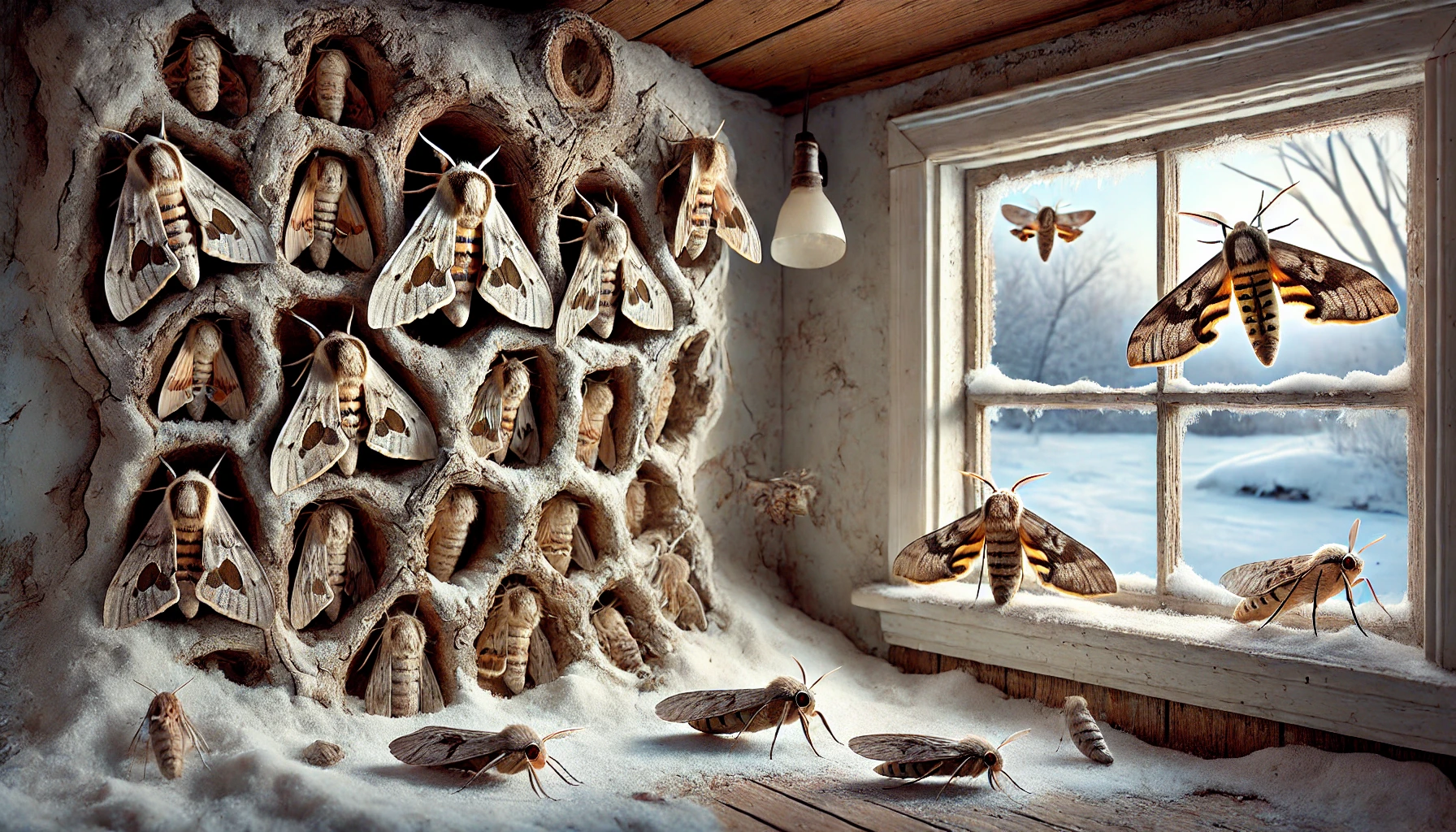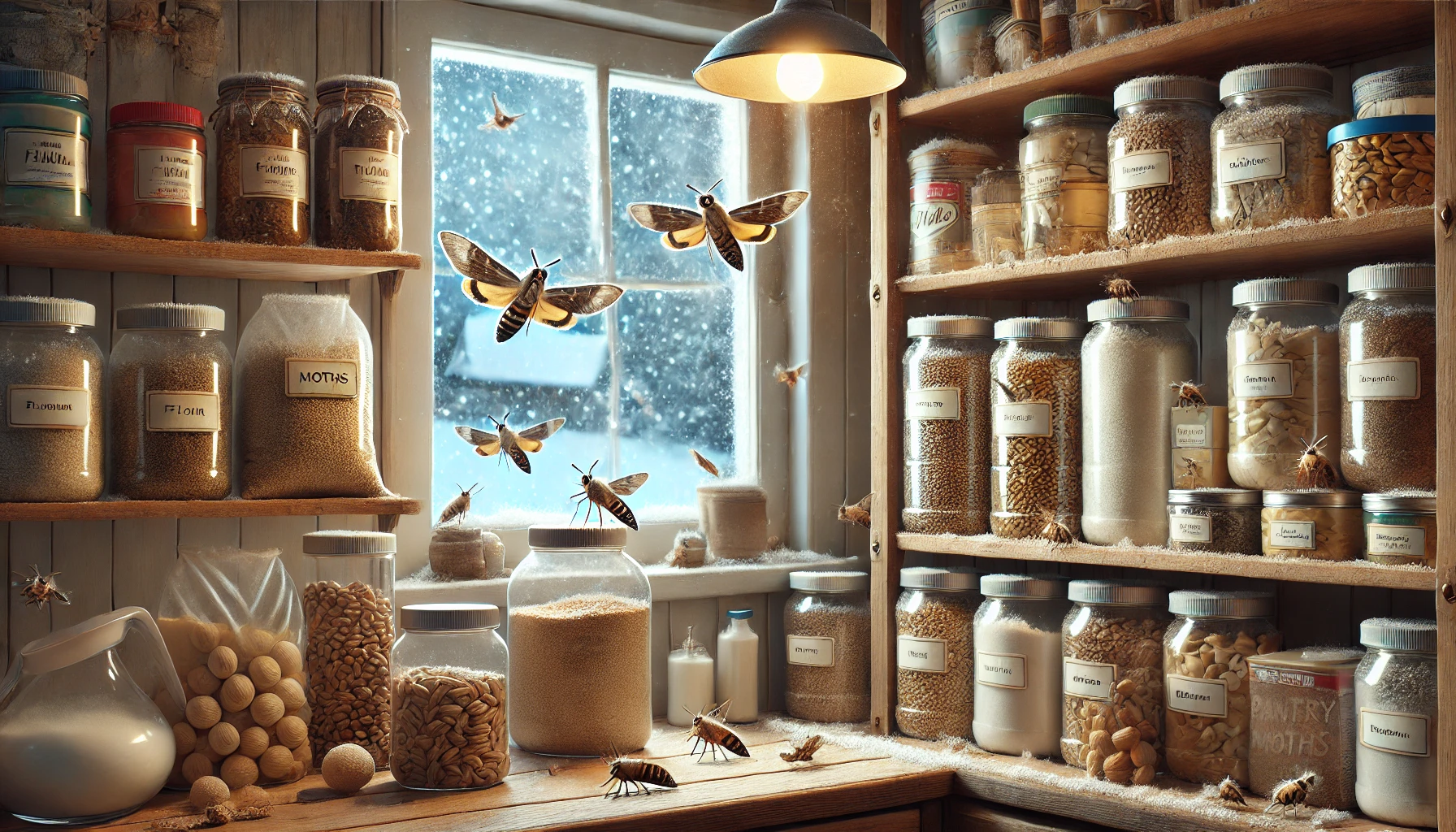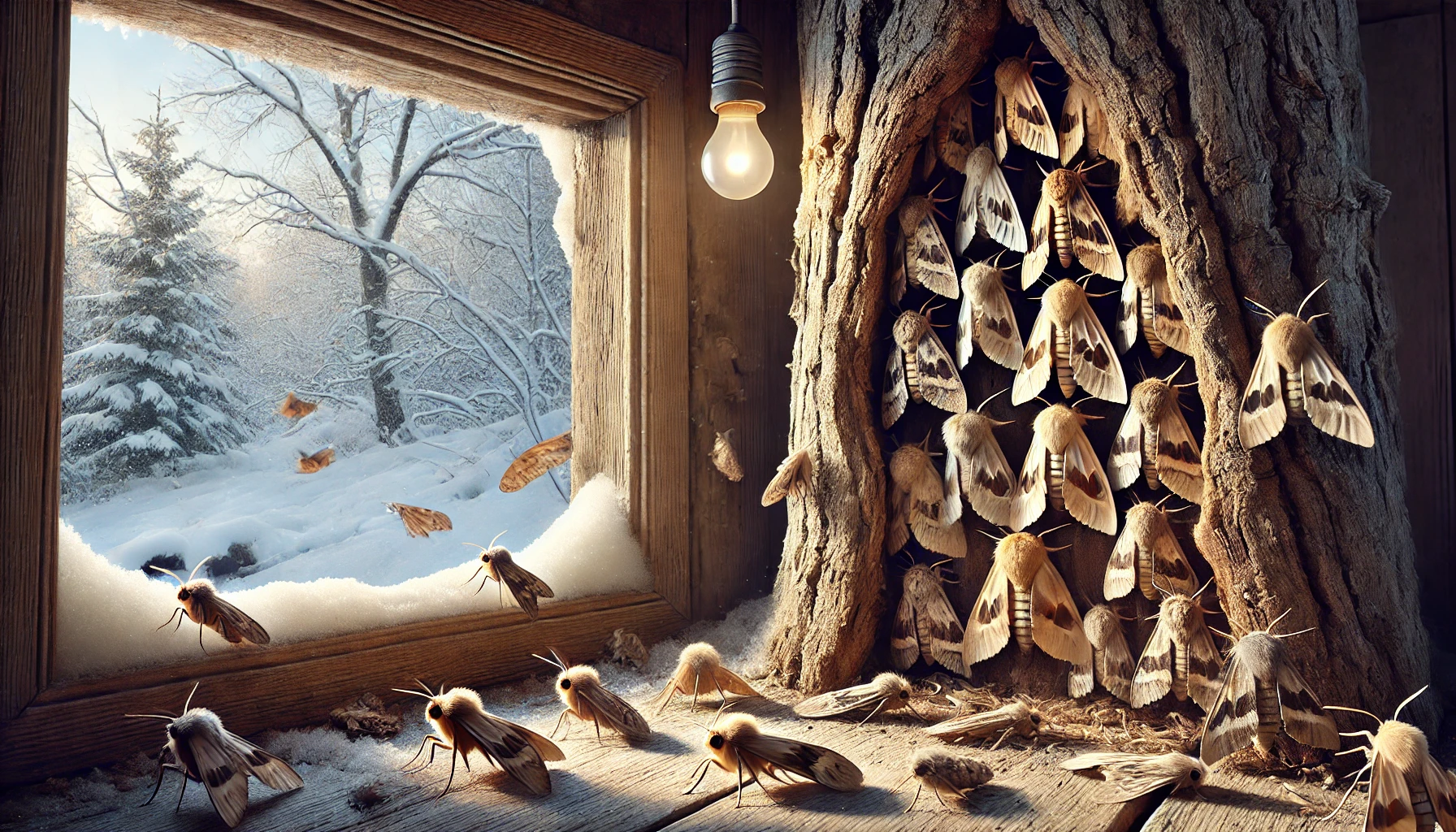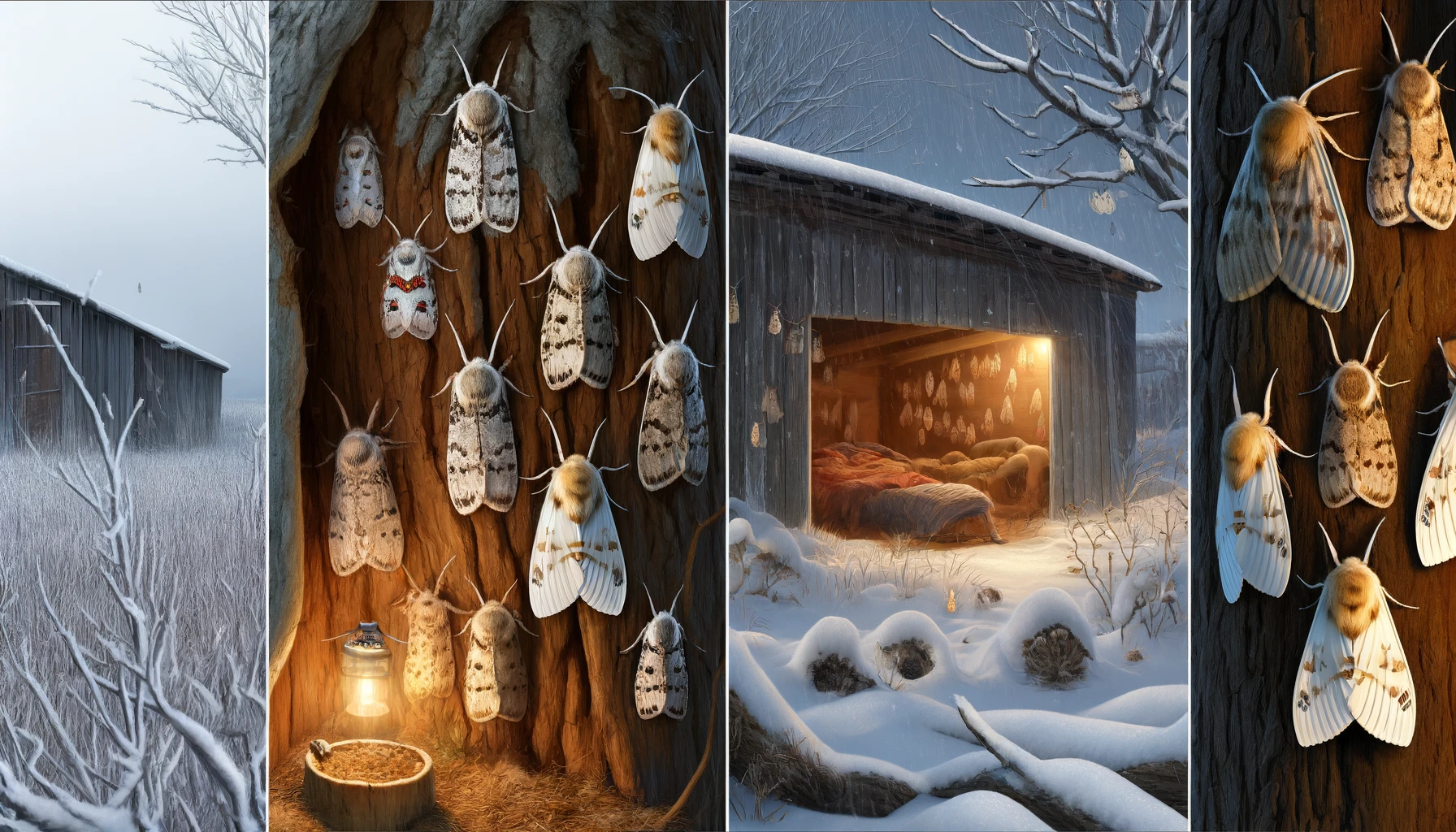Key Takeaways
-
Moths Survive Winter: Moths use various survival strategies, including diapause (larvae dormancy), overwintering in cocoons (pupae), and staying active indoors.
-
Home as a Moth Haven: Your home’s warmth and stored food make it an ideal environment for moths to thrive, particularly pantry and clothes moths during colder months.
-
Common Moth Species: The most common winter moths are clothes moths, which damage fabrics, and pantry moths, which infest food items like grains and cereals.
-
Prevention Tips: Inspect groceries, use airtight containers, clean storage areas, and freeze affected items. Natural deterrents like cedar and lavender also help prevent infestations.
 Tiny Moths are fascinating creatures belonging to the insect order Lepidoptera. Their survival tactics during winter months are diverse and depend on their species and environment. While many people associate moths with warm weather, these insects are resilient and have developed unique behaviors to survive colder months.
In this article, we’ll explore how different types of moths cope with winter conditions and how you can deal with potential infestations in your home.
Tiny Moths are fascinating creatures belonging to the insect order Lepidoptera. Their survival tactics during winter months are diverse and depend on their species and environment. While many people associate moths with warm weather, these insects are resilient and have developed unique behaviors to survive colder months.
In this article, we’ll explore how different types of moths cope with winter conditions and how you can deal with potential infestations in your home.


Not getting a solution?
Get your free pest control estimate today!How Moths Survive the Cold
Moths have evolved several strategies to survive the harsh winter conditions. Their ability to withstand freezing temperatures and limited food resources is remarkable. Here are the primary methods they use: 1. Larvae Dormancy (Diapause) Many moths, including species like the winter moth, spend the majority of their lives in the larval stage, which is also known as the caterpillar phase. During winter, these larvae enter a state called diapause. Diapause is similar to hibernation in animals; it’s a period of suspended development that allows the larvae to survive extreme cold and limited food supply. While in diapause, the larvae are inactive and resistant to freezing temperatures. They can survive for months without eating. When temperatures warm in the spring, the larvae “wake up” and resume feeding on plants, sometimes causing significant damage to trees and crops. For example, the winter moth (Operophtera brumata), a common pest in the northeastern United States, causes defoliation of various trees, such as oaks and maples, during the spring when the larvae feed on leaves. 2. Pupa Overwintering Another common strategy is pupa overwintering. Some moth species, like the spongy moth (formerly known as the gypsy moth), survive the winter in their pupal stage. A pupa is the intermediate stage between larvae and adult moth. These pupae are protected inside cocoons or hidden under tree bark or soil during the colder months. As the temperatures rise in the spring, the pupae mature into adult moths, which then go on to mate and lay eggs for the next generation. Spongy moths are infamous for their ability to cause large-scale damage to forests. Their larvae, which feed on over 300 different plant species, defoliate trees, weakening them and making them more susceptible to disease and death. 3. Adult Moth Activity Though most moths remain dormant in winter, some species are active during this time, especially in milder climates or indoors. One example is the winter moth (Operophtera brumata), which emerges from the soil in late autumn or early winter. Male moths are capable of flight, while the flightless females rely on pheromones to attract mates. Once they mate, females lay eggs, and the larvae hatch in spring. This active mating behavior can lead to indoor infestations, especially when adult moths are attracted to warm, lit areas. These moths often seek shelter inside homes, where they may cause problems in gardens or by feeding on ornamental plants.Moths in Homes During Winter
While moths spend much of the year outdoors, certain species are well-adapted to living indoors. Winter provides an ideal environment for some moths to thrive, especially in warmer indoor settings. Moths seek shelter, food, and warmth, making your home an ideal target for an infestation. 1. Pantry Moths
The Indian meal moth (Plodia interpunctella) is a common indoor pest, especially during colder months. These moths invade kitchens and pantries, laying their eggs on food items like grains, cereals, flour, and pet food. Once the larvae hatch, they burrow into the food, contaminating it and causing waste.
To prevent a pantry moth infestation, it’s important to store dry food in airtight containers and regularly clean pantry shelves to remove any crumbs or food debris. If an infestation is detected, it’s vital to dispose of infested items immediately and thoroughly clean the affected areas.
1. Pantry Moths
The Indian meal moth (Plodia interpunctella) is a common indoor pest, especially during colder months. These moths invade kitchens and pantries, laying their eggs on food items like grains, cereals, flour, and pet food. Once the larvae hatch, they burrow into the food, contaminating it and causing waste.
To prevent a pantry moth infestation, it’s important to store dry food in airtight containers and regularly clean pantry shelves to remove any crumbs or food debris. If an infestation is detected, it’s vital to dispose of infested items immediately and thoroughly clean the affected areas.
 2. Clothes Moths
The webbing clothes moth (Tineola bisselliella) is another species that commonly invades homes, especially in winter when people tend to wear more clothing made from natural fibers like wool, silk, and cotton. Clothes moths are known for their larvae, which feed on these materials, causing holes and significant damage to clothing.
Clothes moths typically infest closets, attics, or drawers where old or seldom-used clothes are stored. To prevent an infestation, ensure that your wardrobe is clean and dry, and store seasonal items in sealed containers. You can also use moth repellents like cedarwood, lavender, or mothballs to deter them.
2. Clothes Moths
The webbing clothes moth (Tineola bisselliella) is another species that commonly invades homes, especially in winter when people tend to wear more clothing made from natural fibers like wool, silk, and cotton. Clothes moths are known for their larvae, which feed on these materials, causing holes and significant damage to clothing.
Clothes moths typically infest closets, attics, or drawers where old or seldom-used clothes are stored. To prevent an infestation, ensure that your wardrobe is clean and dry, and store seasonal items in sealed containers. You can also use moth repellents like cedarwood, lavender, or mothballs to deter them.
Common Moth Species and Their Winter Habits
Several moth species in the United States are known to cause significant problems during winter months. Let’s look at a couple of the most common: Winter Moth (Operophtera brumata)
The winter moth is a significant pest in areas such as New England, New York, and parts of Canada. During late fall and early winter, males emerge to mate, and females lay eggs under tree bark. These larvae begin feeding on tree leaves in early spring, often causing substantial defoliation.
Winter moths are most problematic in urban and suburban areas where ornamental trees are more susceptible to damage. Homeowners often notice this infestation when leaves begin to fall off their trees prematurely.
Winter Moth (Operophtera brumata)
The winter moth is a significant pest in areas such as New England, New York, and parts of Canada. During late fall and early winter, males emerge to mate, and females lay eggs under tree bark. These larvae begin feeding on tree leaves in early spring, often causing substantial defoliation.
Winter moths are most problematic in urban and suburban areas where ornamental trees are more susceptible to damage. Homeowners often notice this infestation when leaves begin to fall off their trees prematurely.
 Spongy Moth (Lymantria dispar)
Spongy moths, also known as gypsy moths, have been causing significant ecological damage across North America for decades. These moths feed on a wide variety of trees, with their larvae causing serious defoliation. As a result, affected trees become weak, which can lead to tree mortality in extreme cases.
This moth species can be particularly dangerous because it feeds on a wide range of trees, from hardwoods to softwoods. The spread of spongy moths has been fueled by global trade, and they are found throughout the U.S.
Spongy Moth (Lymantria dispar)
Spongy moths, also known as gypsy moths, have been causing significant ecological damage across North America for decades. These moths feed on a wide variety of trees, with their larvae causing serious defoliation. As a result, affected trees become weak, which can lead to tree mortality in extreme cases.
This moth species can be particularly dangerous because it feeds on a wide range of trees, from hardwoods to softwoods. The spread of spongy moths has been fueled by global trade, and they are found throughout the U.S.
How to Prevent Moth Infestations
Preventing a moth infestation during winter requires a combination of cleanliness, proper storage, and vigilance. Here are some practical steps you can take: 1. Keep Your Home Clean: Clean your home regularly, particularly in areas where food is stored. Remove any crumbs, spilled food, or debris that could attract moths. Pay special attention to areas such as pantries, closets, and the attic. 2. Store Food Properly: Prevent pantry moths by storing food in airtight containers. This includes grains, cereals, pasta, and pet food. Keeping food sealed will prevent moths from laying eggs and will stop larvae from infesting your supplies. 3. Inspect Secondhand Items: Before bringing secondhand furniture or clothing into your home, inspect them for signs of moth larvae or eggs. Moths often infest these items, and you don’t want to introduce them into your home. 4. Use Moth Traps: Pheromone traps can be very effective for monitoring moth populations. These traps lure adult moths and capture them, reducing the number of new eggs that will hatch.





